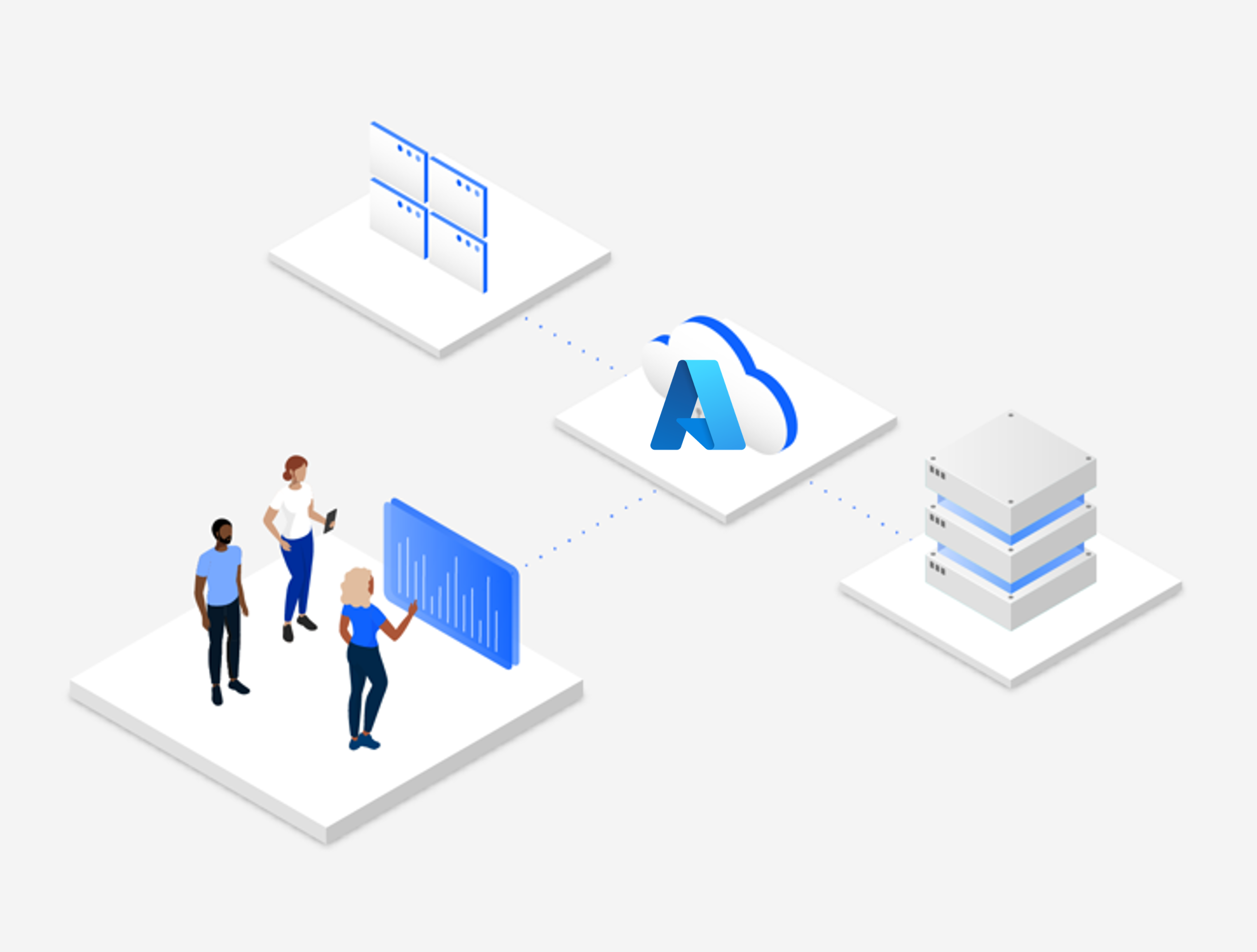For many of the world’s largest organizations, mainframes continue to be essential, with a recent IBM IBV study revealing that 71% of executives report mainframe-based applications are central to their business strategy. And yet, the same survey reveals the urgent necessity to transform these applications to maintain their competitive edge and innovate, adopting a more open approach that includes public cloud.
A separate Microsoft-sponsored study revealed that 95% of respondents considered hybrid and multi-cloud technologies critical to their business success, and this hybrid approach is a key tenet of Microsoft's cloud strategy.
As hybrid cloud architectures mature, IBM and Microsoft have partnered to co-engineer five key patterns that simplify and accelerate architectures that span IBM zSystems mainframe and Microsoft Cloud.
- Accelerating Application Delivery applies DevOps tooling, practices, and culture to mainframe services to provide a seamless app/dev experience throughout the enterprise.
- Simplifying Application Integration enables cloud-native apps to quickly and securely access mainframe-hosted business logic, with no prior knowledge of the underlying service.
- Data Insight & Exploitation derives new meaning from core data, through enriched data analysis in cloud, event streams, or visualization and analysis on live mainframe data.
- Automation for Seamless Operations provides a common approach to manage and operate environments across all platforms throughout the enterprise.
- Optimizing Back-Up & Archive exploits the global reach of cloud storage to extend and simplify the infrastructure and costs associated with creating fail-safe recovery data.

Accelerating Application Delivery
Mainframe application delivery has historically employed waterfall practices, using green screen development tools and library management source code repositories. In addition, developer productivity can be hampered when platform capacity is prioritised for production workloads. Even today, many of these challenges still persist, resulting in inefficient and slow release cycles.
This is in stark contrast to the contemporary cloud-native developer experience, and so the design principle of this pattern has been to integrate the IBM Z and Cloud Modernization Stack components with the capabilities of Azure DevOps, to enhance and accelerate app innovation throughout the enterprise.
- Dev & Test z/OS environments in Azure provide Dev teams unconstrained access to fully supported, IBM z/OS runtimes to build and test the functional aspects of their services, whilst freeing mainframe capacity for production. Developers can rapidly provision/ de-provision virtual z/OS environments using the Wazi Sandbox component, exploiting the powerful self-service and versioned-controlled building blocks of cloud infrastructure.
- Contemporary Dev tooling improves the developer experience and productivity, with widely-adopted technologies such as Visual Studio and Wazi Code, enabling new developers to build and collaborate on mainframe applications from Day 1. In addition, technologies such as Wazi Analyze enables developers to discover, navigate and explore these highly complex and often undocumented applications.
- A comprehensive DevOps experience transcends platform and runtime environments, to seamlessly deliver new services at speed. Technologies such as IBM Dependency Based Build provide a natural mainframe extension to the enterprise-wide delivery capabilities of Azure DevOps.
The reference architecture for the IBM Z and Cloud Modernization Stack and Azure DevOps is available here: https://learn.microsoft.com/en-us/azure/architecture/example-scenario/mainframe/devops-mainframe-ibm-z.
Simplifying Application Integration
There are multiple options for connecting to the business logic encapsulated in mainframe applications, ranging from bespoke network-based adapters, custom technology connectors to file, message, or web service-based solutions. While these are viable integration options, they typically burden the cloud-native developer with knowledge of the underlying implementation. For instance, a typical mainframe interface requires the developer to construct requests in highly complex COBOL copybook structures, with all the relevant fields, flags, REDEFINE statements and so on.
In recent years, organisations have sought more streamlined integration techniques, based on the de facto industry standard of REST APIs. These now extend directly into the mainframe with technologies such as IBM z/OS Connect, which enables developers to discover, build and consume REST APIs directly into z/OS runtimes. The current release now supports the latest OpenAPI 3 standards and improved deployment flexibility means z/OS Connect server instances can reside either on z/OS or Azure.
This provides applications in Azure with a vastly simplified, yet highly secured access path to mainframe business logic. This simplicity also extends the reach of SaaS applications or low-/ no-code services, such as Microsoft Power Platform, directly into the transaction-processing core, and vice versa, with z/OS Connect also enabling mainframe applications to call out to Azure-hosted services.
The reference architecture for REST APIs surfaced by z/OS Connect to Azure native services is available here: https://learn.microsoft.com/en-us/azure/architecture/example-scenario/mainframe/extend-mainframes-to-digital-channels-by-using-standards-based-rest-apis.
Data Insight & Exploitation
The ability for organizations to extract insight from business data provides a key competitive advantage, and yet data is often isolated in silos. This is a particular challenge with mainframe data, that is rich in transactional content and yet can be costly to access. One traditional approach applies ETL or ELT practices to copy data from the mainframe to integrated analytics platforms for later analysis; however the opportunity for real-time data analysis is very limited.
A more sophisticated approach has evolved, which curates specific data in a mainframe-optimized, in-memory cache that serves information through contemporary interfaces, such as REST APIs and event-based mechanisms, including Kafka. This is the concept behind IBM Z Digital Integration Hub (zDIH), which deeply integrates with core z/OS data, and supports fast, easy access for read-requests from Azure-hosted services.
This elevates the mainframe’s system of record data, via both event- and query-based patterns, directly to the consumers that rely on information currency. One example of this is the need to surface up-to-the-minute details directly into CRM systems, such as Microsoft Dynamics 365, in order for staff to have accurate information at their fingertips during customer interactions. Another common scenario is the need to incorporate mainframe data directly into enterprise-wide analytics queries, well suited to the combined capabilities of zDIH and unified analytics platform, Microsoft Fabric.
Automation for Seamless Operations
One of the hallmarks of successful enterprise environments has been the use of automation to build, manage and operate a framework of consistent, repeatable and well-governed infrastructure building blocks. One of the challenges facing operations teams today, is the skills chasm between mainframe and cloud environments – which is particularly acute when building hybrid architectures that span the two.
In recent years, support for Red Hat Ansible Automation Platform has been extended to include specialized Ansible Certified Content for IBM zSystems. This flexible and powerful automation framework provides a new way to orchestrate the management of - and skillsets to operate - z/OS environments. When used in combination with the extensive capabilities and pre-built Ansible in Azure assets, this paves the way for operations and development teams to efficiently deliver infrastructure patterns across all environments, including zSystems and Azure.
Optimising Infrastructure: Back-up & Archive
Creating a fail-safe recovery for the business-critical data that resides on mainframes is essential, but this strategy has remained largely unchanged since its inception. Common practice is to provide multiple, redundant back-up options on disk and tape, replicated across two or more physical locations, resulting in a highly complex infrastructure to manage, and a lengthy back-up process during which mainframe capacity is diverted away from production workloads.
Today, organizations are exploiting the secure, global scale of Azure Blob Storage to reduce back-up and archiving cost whilst optimising infrastructure, performance, and resilience. Solutions such as IBM Cloud Tape Connector for z/OS, have a proven track record in improving mainframe resilience through additional back-up copies in any region globally in Azure. Alternatively, back-up infrastructure can be replaced entirely, massively simplifying environments and reducing back-up times from several hours to a matter of minutes.
Mainframe with Cloud: A Contemporary Approach for a Successful Hybrid Strategy

As organizations embrace their own unique cloud journeys, the mix of on-premises services with cloud is incredibly powerful. These hybrid architecture patterns have been co-engineered in collaboration between Microsoft and IBM’s thought leaders – and are designed to aid the adoption of these most common use-cases.
These are just a few examples of the ways in which organizations can harness the potential of IBM zSystems with Microsoft Cloud – and we’d be fascinated to explore future hybrid patterns. If you would like to learn more about these patterns, or discuss your ideas, please contact the Microsoft team at mainframetransformed@microsoft.com, or the IBM team via the IBM Z and Cloud Modernization Center.

